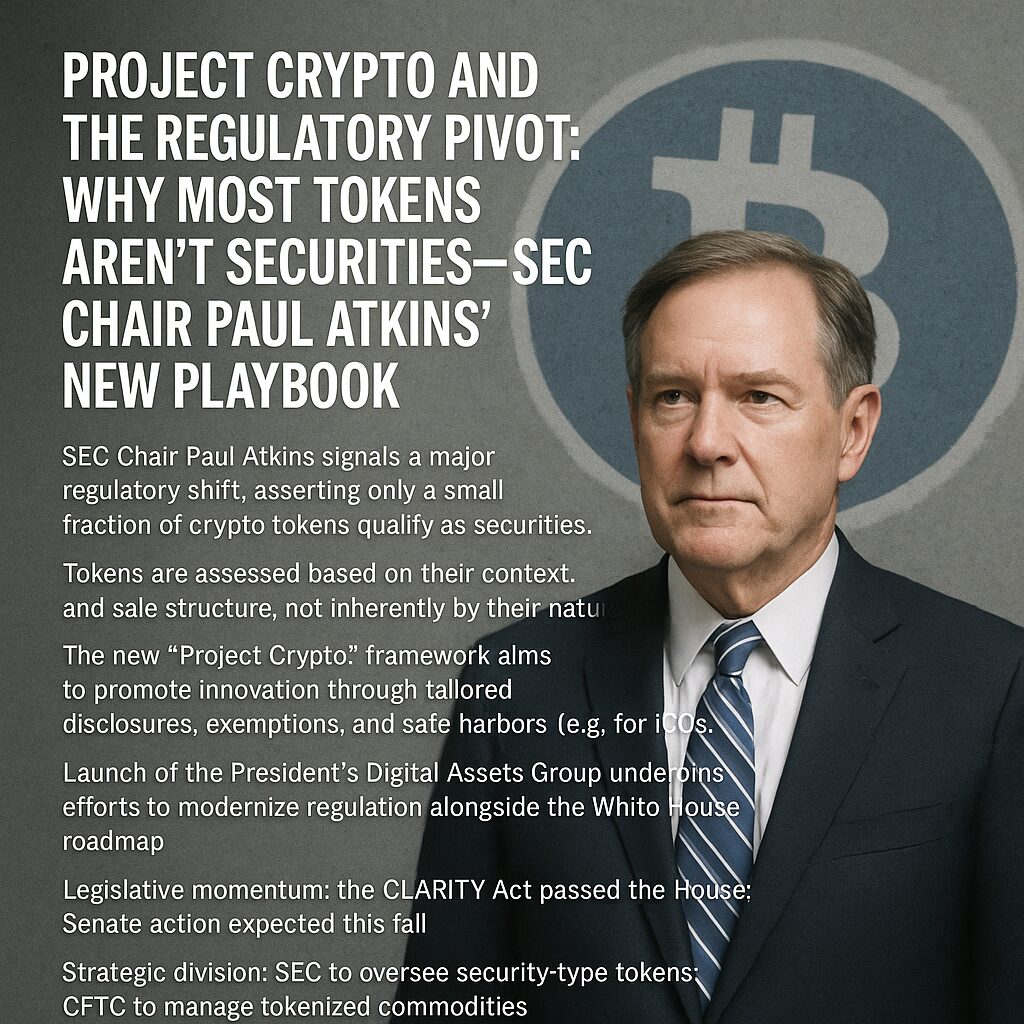
Main Points:
- SEC Chair Paul Atkins asserts that only a small number of crypto tokens qualify as securities.
- Classification depends on the context, not the token itself.
- Launch of Project Crypto to modernize rules and bring U.S. markets on-chain.
- Emphasis on clarity, innovation, and regulatory flexibility, diverging from Gensler-era enforcement.
- Congressional action (e.g., CLARITY Act, GENIUS Act) complements SEC moves.
- The regulatory environment is evolving toward U.S. leadership in digital finance.
1. A Radically Different Position on Crypto Tokens
At the Wyoming Blockchain Symposium, SEC Chair Paul Atkins delivered remarks signaling a significant shift in regulatory attitude. He stated firmly that the token itself is not necessarily a security and likely is not. It is instead the packaging, marketing, and sales mechanism that determine classification. In his words:
“There are very few … tokens that are securities, but it depends on what’s the package around it and how that’s being sold.”
This stance sharply contrasts with former Chair Gary Gensler’s position, which held that the vast majority of crypto assets fell squarely under securities law via the Howey test.
2. Project Crypto: Modernizing U.S. Markets On-Chain
Atkins used this platform to further expand on Project Crypto, an ambitious Commission-wide initiative intended to update the regulatory framework for digital assets. The initiative aims to streamline crypto asset distribution, custody, and trading, aligning them with emerging blockchain-based environments.
Key highlights of Project Crypto include:
- Creating clear guidelines to distinguish between various digital asset types: securities, commodities, stablecoins, or utility tokens.
- Crafting tailored disclosures, exemptions, and safe harbors for offerings such as ICOs, airdrops, and network rewards.
- Supporting “super-apps” offering trading, staking, and lending services across token types under a unified regulatory license.
- Facilitating integration of on-chain systems into traditional financial markets to boost efficiencies.
This proactive proposal marks a pivot away from the enforcement-heavy, retrospective regulation of the past.
3. Legislative Momentum: CLARITY, GENIUS, and Industry Dynamics
Complementing the SEC’s actions, U.S. policymakers are moving swiftly:
- The Digital Asset Market Clarity (CLARITY) Act passed the House in July, aiming to define and regulate digital assets more precisely. Senators are preparing to build upon that foundation.
- The GENIUS Act, also passed in the House, provides a regulatory framework for stablecoins, clearing barriers for banks to issue their own digital currencies.
- Notably, the SEC under Atkins has taken steps to ease enforcement actions: cases against Binance, Coinbase, Kraken, and others have been paused or dropped, while memecoins are explicitly deemed outside its regulatory reach.
These developments suggest a multi-pronged government effort to foster innovation while ensuring integrity.
4. Shaping a U.S. Crypto Agenda: Leadership, Innovation, and Clarity
Atkins framed Project Crypto within a broader vision of American leadership. He cited the President’s Working Group (PWG) report as a blueprint to make the U.S. a global hub for blockchain innovation and emphasized alignment with Trump administration priorities.
The initiative promises:
- Streamlined on‑chain infrastructure in U.S. markets.
- A shift from “regulation by enforcement” to regulatory clarity and support.
- Opportunities for capital formation, fintech innovation, and digital asset deployment within the U.S.
5. Implications for Investors, Innovators, and the Blockchain Community
For individuals and firms seeking new assets, revenue streams, or practical blockchain use cases:
- Regulatory clarity lowers entry barriers for token offerings and DeFi deployments.
- Safe harbors for coin offerings and rewards systems reduce legal risk.
- Clear classification frameworks facilitate strategic planning for token design.
- On‑chain integration enables more efficient, transparent market infrastructure.
- Super-app architectures expand business models by enabling multi-service platforms.
This evolving landscape offers fertile ground for innovation—but participants must stay vigilant, as rulemaking is still in progress.
Conclusion: A New Regulatory Era Is Unfolding
In summary, Chair Paul Atkins’s leadership marks a distinct turn in U.S. crypto policy:
- A more nuanced view on token classification—rejecting blanket application of securities law.
- A forward-looking Project Crypto initiative promoting on-chain systems and innovation.
- Complementing congressional action in passing CLARITY, GENIUS, and other reform bills.
- The strategic goal of re-establishing U.S. leadership in digital finance.
For crypto enthusiasts, developers, investors, and blockchain practitioners, the future holds promise—if navigated with an informed, proactive approach.

